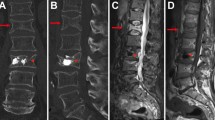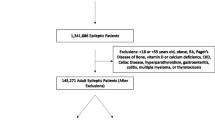Abstract
This study aimed to investigate the prevalence of fractures and non-fracture injuries, including associated risk factors, in children with epilepsy prescribed antiseizure medications (ASM). A controlled, cross-sectional study was conducted in a hospital outpatient setting, comparing children with epilepsy prescribed ASMs with their non-epileptic siblings. Information was collected by questionnaire included history of fractures, non-fracture injuries and epilepsy, comorbidities and ASM use. 261 participants completed the questionnaire, 133 children with epilepsy (aged 10.7 ± 3.5 years, mean ± SD) and 128 siblings (10.1 ± 3.7 years). There were 49 non-seizure-related fractures in 34 ASM patients while prescribed ASMs, compared with 21 lifetime fractures in 15 controls, giving a 2.7 (95% CI 1.3–5.3, p = 0.007) times greater fracture prevalence in children treated with ASMs compared to healthy siblings. The rates of non-fracture injuries were similar across groups, except that concussion was more common in children taking ASMs (9.0% vs 1.6%, p = 0.026). Duration of ASM use and generalized tonic–clonic seizures (GTCS) were independent predictors of fractures (OR 1.55; 95% CI 1.03–2.31, p = 0.03; OR 2.50; 95% CI 1.05–5.94, p = 0.04, respectively). Fewer than 20% of participants and/or their families were aware that ASM use was related to bone health. Children with epilepsy treated with ASMs had a higher fracture prevalence than their sibling controls. Duration of ASM treatment and GTCS were associated with fracture risk. Longitudinal prospective studies are required to further explore risk and the direct impact of epilepsy on bone health.


Similar content being viewed by others
Availability of Data and Materials
Research data will be made available electronically, by request only.
References
Shen C, Chen F, Zhang Y, Guo Y, Ding M (2014) Association between use of antiepileptic drugs and fracture risk: a systematic review and meta-analysis. Bone 64:246–253
Shiek Ahmad B, Hill K, O’Brien T, Gorelik A, Habib N, Wark J (2012) Falls and fractures in patients chronically treated with antiepileptic drugs. Neurology 79(2):145–151
Gniatkowska-Nowakowska A (2010) Fractures in epilepsy children. Seizure 19(6):324–325
Lidgren L, Nilsson B, Wallöe A (1979) Bone mineral content in epileptics. Calcif Tissue Int 28(1):99–102
Lidgren L, Wallöe A (1977) Incidence of fracture in epileptics. Acta Orthop Scand 48(4):356–361
Hakami T, O’Brien TJ, Petty SJ, Sakellarides M, Christie J, Kantor S et al (2016) Monotherapy with levetiracetam versus older AEDs: a randomized comparative trial of effects on bone health. Calcif Tissue Int 98(6):556–565
Dimić M, Dimić A, Milosević Z, Vojinović J (2013) Bone mineral density in children with long-term antiepileptic therapy. Srp Arh Celok Lek 141(5–6):329–332
Coppola G, Fortunato D, Auricchio G, Mainolfi C, Operto F, Signoriello G et al (2009) Bone mineral density in children, adolescents, and young adults with epilepsy. Epilepsia 50(9):2140–2146
Simm PJ, Seah S, Gorelik A, Gilbert L, Nuguid J, Werther GA et al (2017) Impaired bone and muscle development in young people treated with antiepileptic drugs. Epilepsia 58(11):1931–1938
Sheth R, Binkley N, Hermann B (2008) Progressive bone deficit in epilepsy. Neurology 70(3):170–176
Pack AM (2011) Treatment of epilepsy to optimize bone health. Curr Treat Options Neurol 4:346
Appleton R (2002) Seizure-related injuries in children with newly diagnosed and untreated epilepsy. Epilepsia 43(7):764–767
Pack A, Morrell M (2004) Epilepsy and bone health in adults. Epilepsy Behav 5:24–29
Petty SJ, O’brien T, Wark J (2007) Anti-epileptic medication and bone health. Osteoporos Int 18(2):129–42
Petty SJ, Hill KD, Haber NE, Paton LM, Lawrence KM, Berkovic SF et al (2010) Balance impairment in chronic antiepileptic drug users: a twin and sibling study. Epilepsia 51(2):280–288
Wood E, Rosenbaum P (2000) The gross motor function classification system for cerebral palsy: a study of reliability and stability over time. Dev Med Child Neurol 42(5):292–296
Fraser JA, Burneo J, Fraser L-A (2015) Fracture risk associated with enzyme-inducing antiepileptic drugs in patients with epilepsy: a systematic review (P4.274). Neurology 84(14 Supplement)
Svalheim S, Røste L, Nakken K, Taubøll E (2011) Bone health in adults with epilepsy. Acta Neurol Scand 124(s191):89–95
Panayiotopoulos CP, Koutroumanidis M, Giannakodimos S, Agathonikou A (1997) Idiopathic generalised epilepsy in adults manifested by phantom absences, generalised tonic-clonic seizures, and frequent absence status. J Neurol Neurosurg Psychiatry 63(5):622–627
Miller J (2011) Fractures in adults and children. JAMA 305(11):1140
Van Staa TP, Dennison EM, Leufkens HGM, Cooper C (2001) Epidemiology of fractures in England and Wales. Bone 29(6):517–522
Verrotti A, Greco R, Latini G, Morgese G, Chiarelli F (2002) Increased bone turnover in prepubertal, pubertal, and postpubertal patients receiving carbamazepine. Epilepsia 43(12):1488–1492
Henneicke H, Gasparini S, Brennan Speranza T, Zhou H, Seibel M (2014) Glucocorticoids and bone: local effects and systemic implications. Trends Endocrinol Metab 25(4):197–211
Barkley R (2014) ADHD and injuries: accidental and self-inflicted. ADHD Rep 22(2):1–8
Goldberg-Stern H, Itzhaki T, Landau Z, de Vries L (2015) Endocrine effects of valproate versus carbamazepine in males with epilepsy: a prospective study. Horm Res Paediatr 83(5):332–339
Herzog AG, Mandle HB, MacEachern DB (2019) Does the age of seizure onset relate to menarche and does it matter? Seizure 69:1–6
Dworetzky BA, Townsend MK, Pennell PB, Kang JH (2012) Female reproductive factors and risk of seizure or epilepsy: data from the Nurses’ Health Study II. Epilepsia 53(1):e1-4
Acknowledgements
The authors thank the following for participation and assistance in this study: participants and their families; neurologists and other staff at the Royal Children’s Hospital Melbourne (RCH) epilepsy clinics.
Funding
No funding including honorariums or grants were obtained for the use of this research or manuscript production. The authors have full control of all primary data and agree to allow Calcified Tissue International to review the data if requested.
Author information
Authors and Affiliations
Corresponding author
Ethics declarations
Conflict of interest
J.L. Freeman reports having received consulting fees from Eisai Australia, Liva Nova Australia and from UCB Australia. J.D. Wark has received grants-in-aid for unrelated projects in epilepsy treatment by UCB Pharma and Novartis. S.M. Kumar, P.J. Simm, M. De Silva, A. Gorelik, M.T. Mackay, B. Shiek Ahmad and S.J. Petty reports no disclosures.
Ethical Approval
The study was approved by the Royal Children’s Hospital Human Research Ethics Committee (HREC35100A).
Consent to Participate
Written informed consent was obtained from participants over the age of 18 years and from parents or guardians of participants under the age of 18 years.
Consent for Publication
All authors have consented to the submitted manuscripts publication.
Human and animal rights
Human rights were followed as the study was conducted under the approval of our HREC. Animal rights were not relevant as this is a study in humans.
Additional information
Publisher's Note
Springer Nature remains neutral with regard to jurisdictional claims in published maps and institutional affiliations.
Supplementary Information
Below is the link to the electronic supplementary material.
Rights and permissions
About this article
Cite this article
Kumar, S.M., Simm, P.J., De Silva l, M. et al. Risk of Fractures and Other Injuries in Children Treated with Antiseizure Medications for Epilepsy. Calcif Tissue Int 109, 139–146 (2021). https://doi.org/10.1007/s00223-021-00842-3
Received:
Accepted:
Published:
Issue Date:
DOI: https://doi.org/10.1007/s00223-021-00842-3




